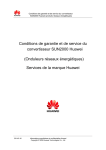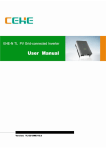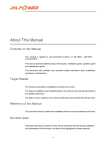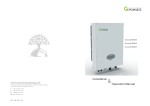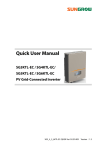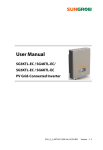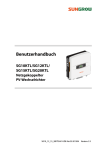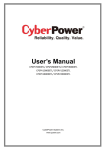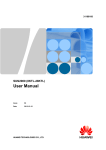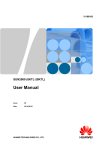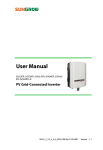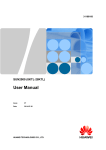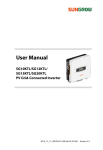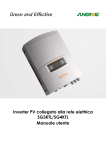Download Installation & Operation Manual for Inverter of 10
Transcript
THE POWER OF ASTRONERGY INSTALLATION & OPERATION MANUAL FOR INVERTER OF 10~20KTL INSTALLATION & OPERATION MANUAL FOR INVERTER OF 10~20KTL 1. Introduction 1.1 1.2 1.3 1.4 Validity Target Group Product Overview Safety 7. Operation Modes 7.1 7.2 7.3 Normal mode Fault mode Shutdown mode 8. LCD Display 2. Unpacking 2.1 2.2 Unpacking and Inspection Information of Label 3. Mounting 3.1 3.2 3.3 Safety instruction Selecting the Installation Location Installation guidance 4. Electrical Connections 4.1 4.2 4.3 4.4 Types of Grid Structure and Connection Compatibility Wiring AC Output Wiring DC Input RS485 cable connection 5. Heat Dissipation Maintenance 5.1 5.2 Cleaning Fans and Grills Exchanging Fan 6. Commission the Inverter 8.1 8.2 8.3 8.4 8.5 Country Setting General LCD display Operate by knock Data checking and parameters setting Inverter faulty messages 9. Communitions 9.1 9.2 9.3 9.4 Astronergy Net Astronergy Vision Astronergy Pano Astronergy WebBox 10. Trouble Shooting 10.1 10.2 General question Error Messages displayed on LCD 11. Specifications 12. Astronergy Factory Warranty 13. Warranty Conditions 14. Contact 1 1. Introduction 1.1Validity This installation guide contains installation, commissioning, communication, trouble shooting. information of Astronergy CHPI KTL series inverters: CHPI 10KTL CHPI 12KTL CHPI 18KTL CHPI 20KTL With this installation guide, users are able to install and operate the inverters easily. This manual does not cover any details concerning equipment connected to the Astronergy CHPI KTL. Store this manual where accessible at all times. 1.2 Target Group This manual is for qualified persons such as PV system installers or electricians. Notes: For possible changes in this manual, Chint Solar(Zhejiang) Co., Ltd. accepts no responsibilities to inform the users. 1.3 Product Overview Astronergy CHPI KTL series inverters are grid-tied inverters which convert DC current generated by PV modules into AC current and feed it into the public grid in threephase. Astronergy CHPI KTL series inverters are multi-string inverters with multi-MPP trackers, which mean they are able to connect to different PV module arrays. Inverters Overview: Fig 1.1 2 Position Description A LCD B LED C PV input terminals D DC Switch E AC output F RS232 lid G RS485 H Series Number I Warning Label J Type label Symbol on the inverter Symbol Description Explanation Tap symbol Indicates display operation (see Section 6). Green/constant Operation Red/constant 1. Fault-- contact installer 2. Standby module Red/flashing 1. Fans Fault-- contact installer 2. Software update Inverter status symbol 3 Grid-tied PV system Overview: Input A DC Breaker Astronergy CHPI KTL Inverter AC Breaker Energy meter Public grid Input B DC Breaker Fig 1.2 As drawings shown above, a complete Grid-tied PV system consists of PV modules, PV inverters, public grid and other components. Moreover, PV inverters always act as key components. The Astronergy CHPI KTL series inverters may only be operated with PV generators (modules and cabling) with protective insulation. Do not connect any source of energy other than PV modules to the Astronergy CHPI KTL series. When design a PV system contains Astronergy CHPI KTL series inverters or any other Astronergy inverters, the system designing software AstronergyDesign (download from site: www.astronergy.com) will provide adequate supports. Notes: If PV modules of the PV system require POSITIVE or NEGATIVE GROUND, or the capacitance relative to ground of the modules is large, please contact Astronergy for technical support before installation. 1.4Safety Astronergy CHPI KTL is designed to use worldwide, hence the inverters meet different safety standards of variety countries and regions. VDE-AR-N 4105; BDEW; CEI 0-21; IEC 62109 1/2; VDE0126-1-1; RD1663; G59; CE DANGER! Danger to life due to high voltages in the inverter! All work on the inverter may be carried out by qualified personnel only. The appliance is not to be used by children or persons with reduced physical, sensory or mental capabilities, or lack of experience and knowledge, unless they have been given supervision or instruction. Children should be supervised to ensure that they do not play with the appliance. 4 CAUTION! Danger of burn injuries due to hot enclosure parts! During operation, the upper lid of the enclosure and the enclosure body may become hot. Only touch the lower enclosure lid during operation. CAUTION! Possible damage to health as a result of the effects of radiation! Do not stay closer than 20 cm to the inverter for any length of time. Grounding the PV generator Comply with the local requirements for grounding the PV modules and the PV generator. Astronergy recommends connecting the generator frame and other electrically conductive surfaces in a manner which ensures continuous conduction and ground these in order to have optimal protection of the system and personnel. CAUTION! Possible damage the PV modules as a result of Identification of String Failure! The Astronergy CHPI KTL Inverter is equipped with a system which recognizes total failure of individual strings or part-strings. 2. Unpacking 2.1 Unpacking and Inspection Before opening the packing box of Astronergy CHPI KTL, please note that whether there are any visible external damages. Once open the packing box, please check the delivery for completeness and for any visible external damages of the inverter. If there are anything damaged or missing, please contact your dealer. Complete delivery should contain as follows. 5 Fig 2.1 Item Number Description A 1 CHPI KTL inverter B 1 Mounting frame C 1 Waterproof cover D 6/8 Explosion screw E 2 RS485 connector F 1 Cable gland for AC connection G 4 M4 cross recessed countersunk head screws H 3 M6 socket head cap screws I 2 Flat mat —— 1 Warranty(not show in the picture) —— 1 User manual (not show in the picture) Hint: Number of D is 6 for CHPI 10/12 KTL, and 8 for CHPI 18/20 KTL. Notes: Though the packaging box of Astronergy CHPI KTL is durable, please treat the packing box gently and avoid dispose the packing box. 6 2.2 Information of Label The label contains information as below: • The inverter type/model (Model Name); • The certificates and approvals (Certificate Number and Logos at the bottom of thelabel); • Specifications of the inverter (From UDCmax to Operation Ambient Temperature). 3. Installation 3.1 Safety instruction Danger to life due to fire or explosion • Despite careful construction, electrical devices can cause fires. • Do not install the inverter on easily flammable materials and where flammable materials are stored. Risk of burns due to hot enclosure parts Mount the inverter in such a way that it cannot be touched inadvertently. • All electrical installations shall be done in accordance with the local and national electrical codes. Do not remove the casing. Inverter contains no user serviceable parts. Refer servicing to qualified service personnel. All wiring and electrical installation should be conducted by a qualified service personnel. • Carefully remove the unit from its packaging and inspect for external damage. If you find any imperfections, please contact your local dealer. • Be sure that the inverters connect to the ground in order to protect property and personal safety. • The inverter must only be operated with PV generator. Do not connect any other source of energy to it. • Both AC and DC voltage sources are terminated inside the PV Inverter. Please disconnect these circuits before servicing. • This unit is designed to feed power to the public power grid (utility) only. Do not connect this unit to an AC source or generator. Connecting Inverter to external devices could result in serious damage to your equipment. 7 • When a photovoltaic panel is exposed to light, it generates a DC voltage. When connected to this equipment, a photovoltaic panel will charge the DC link capacitors. • Energy stored in this equipment’s DC link capacitors presents a risk of electric shock. Even after the unit is disconnected from the grid and photovoltaic panels, high voltages may still exist inside the PV‐Inverter. Do not remove the casing until at least 5 minutes after disconnecting all power sources. • Although designed to meet all safety requirements, some parts and surfaces of Inverter are still hot during operation. To reduce the risk of injury, do not touch the heat sink at the back of the PV‐Inverter or nearby surfaces while Inverter is operating. 3.2 Selecting the Installation Location This is guidance for installer to choose a suitable installation location, to avoid potential damages to device and operators. 1) The wall selected to install the inverter must be strong and firm enough to support and bear the weight of the inverter for a long period time. (Refer to Chapter 11 Specifications) 2) The location selected must be suitable for inverters’ dimension. (Refer to Fig 3.2 Required Clearances) 3) Do not install the inverter on structures constructed of flammable or thermo labile materials. 4) Never install the inverter in environment of little or no air flow, nor dust environment. 5) The Ingress Protection rate is IP65 which means the inverter can be installed outdoors and indoors. 6) Do not expose the inverter to direct sunlight, in order to avoid the power and efficiency derating caused by excessive heating. 7) The humidity of the installation location should be 0~95% without condensation. 8) The ambient temperature of the inverter should be ‐25 °C~+60 °C. 9) The installation location must be freely and safely to get at all times. 10) Vertically installation and make sure the connection of inverter must be downwards. Never install horizontal and avoids forward and sideways tilt.( Refer to drawings below) Fig3.1 8 11) Notice the minimum clearances of the inverter. (Refer to Fig 3.2 Required Clearances). Fig3.2 12) Do not install the inverter near television antenna or any other antennas and antenna cables. 13) Do not install the inverter in living area, the noise caused by the machine may affect on daily life. 14) For security reasons, don’t install the inverter in place where the children can reach. 3.3 Installation guidance 3.3.1 Mounting the Bracket In order to avoid electrical shock or other injury, inspect existing electronic or plumbing installations before drilling holes. To mount the inverter on the wall, we should mount the bracket to the wall firmly first of all a) Bracket of CHPI 10KTL/12KTL b) Bracket of CHPI 18KTL/20KTL Fig3.3 9 Hint: Data units in mm Steps: • Drill holes for screws while use the mounting frame as template.6 holes for CHPI 10/12KTL and 8 for CHPI 18/20KTL. • Fix the mounting frame on the wall as the figures shown below, combine as the screws as the Items Fig 2.1 shows (items D) Fig 3.4 3.3.2 Mounting Inverter Falling equipment can cause serious or even fatal injury, never mount the inverter on the bracket unless you are sure that the mounting frame is really firmly mounted on the wall after carefully checking. After the bracket is firmly mounted on the wall, then mount the inverter on the bracket. • Rise up the CHPI KTL a little higher than the bracket. Considering the weight of CHPI KTL, you need to hang on the inverter. During the process please maintain the balance of the CHPI KTL. • Hang the inverter on the bracket through the match hooks on bracket and the back of the inverter. • Installed one M6*10 screw at each side of inverter to reliable fixed it on the wall. Please reference in Fig3.5(b). • Connect the inverter to the earth. Please reference in Fig3.6. • Recommend awning installation, the purpose is to extend the inverter service life and reduce the power derating of the inverter. The dimensions of awning refer to Fig 3.8. a) 10 Fig 3.5 b) Fig 3.6 3.3.3 Installation layout Avoid exposing inverter to direct sunlight, rain or snow to extend the inverter service life despite the IP65 protection degree. Exposure to the sunlight may cause additional internal heating which will cause power derating. Fig 3.7 11 Fig 3.8 Roof 500mm >400mm 1000mm >450mm More than one inverter need to be installed, the dimensions below should be considered. Ground Fig 3.9 12 4. Electrical Connections 4.1 Types of Grid Structure and Connection Compatibility Grid type TN-C grid Types TN-S grid TN-C grid TN-C-S grid TT grid IT grid TN-S grid TN-C-S grid TT grid IT grid CHPI 10KTL yes (N and PE of inverter both should connect to PEN of grid.) yes yes yes, if UN-PE < 30V no CHPI 12KTL yes (N and PE of inverter both should connect to PEN of grid.) yes yes yes, if UN-PE < 30V no CHPI 18KTL yes (N and PE of inverter both should connect to PEN of grid.) yes yes yes, if UN-PE < 30V no CHPI 20KTL yes (N and PE of inverter both should connect to PEN of grid.) yes yes yes, if UN-PE < 30V no 13 4.2 Wiring AC Output You must install a separate three-phase circuit-breaker or other load disconnection unit for each inverter in order to ensure that the inverter can be safely disconnected under load. Measure the public grid voltage and frequency (Voltage: 400Vac; Frequency: 50Hz; in 3-Phase); Open the breaker between the PV inverter and utility; Screw’s torsional force is 8 kg/cm; * Specification of AC breaker: CHPI 10KTL/12KTL:25A/400V CHPI 18KTL/20KTL:50A/400V Cable requirements: Model Diameter(mm) Area(mm²) AWG 10KTL 2.05~4.11 4~16 12~6 12KTL 2.05~4.11 4~16 12~6 18KTL 2.59~4.11 6~16 10~6 20KTL 2.59~4.11 6~16 10~6 Conductor cross section 14 Max. cable length CHPI 10KTL CHPI 12KTL CHPI 18KTL CHPI 20KTL 6.0 mm² 53m 44m 29m 26m 10.0 mm² 88m 73m 49m 44m 16.0 mm² 141m 116m 78m 71m AC connector type Available wire gauge AC Screw Terminal 6.0-16.0 mm² AC Screw Terminal: 1. The AC side terminals of the inverter are like the following figure, it is clear to confirm that ‘L1, L2, L3’ represents three live line output, ‘N’ represents neutral line and ‘ ‘ is grounding line. N L1 L2 L3 Fig 4.2.1 2. Connect five standard cables into relevant terminals. The five cables should be put through the protection shell, as figure below. N L1 L2 L3 Fig 4.2.2 3. Fasten the protection shell onto the bottom of the inverter, make sure the four screws are tight, the completed appearance is like the below figure. N L1 L2 L3 Fig 4.2.3 15 4.3 Wiring DC Input 1 Check the connection cables of the PV modules for correct polarity and make sure that the maximum input voltage of the inverter never exceed 1000Vdc. 2 The diagram drawing of DC side is shown as below, notice that the connectors are in paired (male and female connectors). The connectors for PV arrays and inverters are H4 (AMPHENOL) connectors; MPP Tracker A MPP Tracker B Do not disconnect under load! NL DC switch 1 L2 L3 RS-232 RS-485 Fig 4.3.1 Fig 4.3.2 3 Check the assembled DC connectors for correct polarity and connect them to the inverter. 4 The maximum string currents are varying from different inverter types. 16 Type Max.current 10KTL 15A 12KTL 17A 18KTL 23A 20KTL 26A 5 Cable requirements: 4.4 Model Diameter(mm) Area(mm²) AWG 10KTL 2.05 3.332 12 12KTL 2.05 3.332 12 18KTL 2.05 3.332 12 20KTL 2.05 3.332 12 RS485 cable connection Type 1: 1. Unscrew the plastic connector. 2. Make the RS485 cable go through the connector. 3. Put two heat shrink tubes onto the front head of RS485 cable. Heat shrink tube 4. Insert the two metal head into relevant small cupreous hole, and fasten the connection by soldering. 17 5. Make the heat shrink tubes wrap the joint. 6. Assemble the connector. 7. Connect the RS485 connector onto the inverter. Make sure the connection matched (‘1’ to ‘1’, ‘2’ to ‘2’). Type 2: 1. Please loosen four screws, take down the RS485 waterproof cover from inverter. If you don’t choose RS485 as communication method, keep it on the inverter. 2. Slightly loosen the swivel nut, remove the filler-plug from the M16 cable gland. 18 3. Make the cable through the hole of cable gland and put the cable into the RS485 terminals, fix all cables with screwdriver (‘1’to’1’, ‘3’to’3’, ‘2’ to the shielding layer or no connection.). The type of cable is recommended as “KVVRP22/2*1.5mm2”. Pull cables outwards to confirm whether they are installed firmly 4. Plug in two terminals. Cover the fix board. Tighten 4 pcs screws first, then tighten cable gland. 5. Tighten 4pcs screws and cable gland. Note: 1) As to the connection between inverters, please refer to the following figure. 1 23 1 23 RS 485 terminal of the inverter 1 1 23 1 23 RS 485 terminal of the inverter 2 2) As to the connection between inverter and ShineWebBox (ShinePano), please refer to the following figure. 1 23 RSRS485 inverter 485terminal terminal of of the the inverter COM Comport port Com of of Astronergy WebBOX Shine WebBOX 19 5. Heat Dissipation Maintenance Heat dissipation is important to reduce the power derating when Astronergy inverters working under high ambient temperature. Astronergy inverters are equipped with cooling fans on the top of the shell. When the temperature is high, fans start work to lower the ambient temperature. Once the output power is derating because of too high warming, some tips can help you solve such problems: • The air grills or cooling fans are clogged. To clean the air grills and cooling fans please refer to 5.1 Cleaning Fans and Grills. • One or two cooling fans failed. To exchange the cooling fans please refer to 5.2 Exchanging Fans. • Poor ventilation of installation location. Choose appropriate installation location before mounting. 5.1 Cleaning Fans and Grills Maintain fans and grills every half a year to reduce the power derating caused by high warming. If the fans or grills are just covered by soft dust particles, using tools such as vacuum cleaner to clean the fans. And if user has no such tools or there are obstructions in fans, grills or the cooling area of inverter, you need to clean the fans and grills after they are took apart from the inverter. 1. Please disconnect the DC and AC connection. • Turn off the DC switch. • Disconnect the DC terminal. (You might need some tool to disconnect the male and female terminals) • Disconnect the AC terminal. 20 2. Remove the protecting plants at the bottom of CHPI KTL inverter. Remove the inverter from mounting bracket, and place inverter horizontally on clean and dry place. 3. Screw off the screws to open the cover with suitable tool, then fans will be seen, as figures below: Fig 5.1.1 4. Pull out the white connectors with some tinny tools. Fig 5.1.2 5. Take away the fans from the cover and clean them thoroughly. Fig 5.1.3 21 6. When finishing cleaning, put back the fans in reverse order. 5.2 Exchanging Fan Sometimes the heat dissipation error occurred because the cooling fans failed, under such circumstances, one need exchange the cooling fans. 6. Commission the Inverter 1) Remove all covers from the PV array. 2) Check the PV and AC voltage. 3) Plug in the PV input. Fig 6.1 4) Turn the DC Disconnect to position "I". 5) If the inverter is connected with PV panel arrays and the input voltage is higher than 300Vdc, while the AC grid is not connected yet, LCD will display messages in order as below: Company info Basic info State info The LCD will display “ AC V outrange “at State info and the LED turns red. Please check all information on the LCD, operate by knocks you will see the different parameters. Single knock to Light the backlight State info (single knock) Input info (single knock) Output info 6) Turn on the AC breaker between inverter and grid, the system will operate automatically. 7) Under normal operating conditions, the LCD displays ‘Power: xx.xx Kw’ at State info, this is the power feed into grid. The LED turns green. 8) Check the time and date of inverter as follow: Single knock to Light the backlight State info (Thrice knock) Inverter info (single knock) System Time(double knock), if they are not correct, please set them, refer to 6.3.4 or 6.4.3 text line. 9) Finish commissioning. 7. Operation Modes 7.1 Normal Mode In this mode, the inverter works normally and LED turns green. Whenever the DC voltage is higher than 350Vac, inverter converts power to grid as generated by the PV panels; Whenever the DC voltage is lower than 300Vac, the inverter will work in waiting state and attempt to connect the grid. In waiting state the inverter consumes just enough power generated by the PV panel to monitor the internal system Notes: The inverter starts up automatically when DC power from the PV panel is sufficient. 22 7.2 Fault Mode The internal intelligent controller can continuously monitor and adjust the system status. If inverter finds any unexpected conditions such as system fault and inverter fault, the fault information will be displayed on the LCD. In fault mode the LED turns red. Notes: Detailed fault information refers to Chapter 10.2 ERROR messages displayed on LCD. 7.3 Shutdown Mode Inverters automatically stop running during periods of little or no sunlight. In shutdown mode the inverters take no power from the grid and panel, and the LCD and LED turns off. Notes: If the PV string DC voltage is too low, the inverter will also turn to Shutdown Mode. 8. Country Setting and LCD Display In the lower right corner of inverter there is the LCD display. We can check inverter running status, historical generation data, etc, on the LCD screen. Items displayed can be changed by knock; you can also change some inverter parameters by knock. 8.1 Country Setting If it is the first time the inverter starts up after installation, LCD will quickly switch to and stay at the country setting interface. Only the inverter is set to comply with a certain country rule, it will work and display normally. Otherwise, LCD will always stay at the ’Please select’ interface. Please finish the country setting according to the following steps: 1. When at the first interface ‘Select country :’, the option is ‘VDE0126’ in default. By single knock, countries will vary from one to another, for example, ‘France’, as Fig 8.1.2. Fig 8.1.1 Fig 8.1.2 * If you have ordered the inverter with specific country settings, the parameters have been preset in factory and you don't need to operate this step any more. 23 2. There are eleven countries/rules to select: 1 VDE0126 2 Germany 3 France 4 Italy 5 Greece 6 Hungary 7 Belgium 8 Turkey 9 Denmark 10 Spain 11 UK-G59 Note: if you can’t find the country you want, please directly select ‘VDE0126’. 3. When it comes to the country you want, double knock to enter, as Fig 03. Fig 8.1.3 4. When enter the confirm interface, there are two options ‘NO’ and ‘YES’, and the cursor will stay at ‘NO’ in default, single knock to shift between ‘NO’ and ‘YES’, double knock to confirm your selection. When at ‘NO’, double knock will exit, when at ‘YES’, double knock will set up. After the setting is successful, the LCD will display ‘Set Country OK’, and inverter will reboot automatically. Fig 8.1.4 24 8.2 Power on Display 8.2.1 Power on display After inverter restarts, LCD background will light automatically. Astronergy Logo will appear immediately. The background light will last for 2 seconds. See Fig8.2.1 for reference. Fig8.2.1:Power on Astronergy Logo After displaying Astronergy Logo for 2 seconds, LCD screen will switch to the second interface, display the figure of inverter, company name, inverter’s power rating, etc. The second interface will last for 3 seconds. See Fig8.2.2 for reference. PV Inverter 18 KTL Fig 8.2.2:The second power on interface After 3 seconds, it will switch to the third interface. See Fig8.2.3 for reference. Fig8.2.3:The third power on interface Here are explanation of items on Fig8.2.3: No. : serial number of this inverter. Model:model name of this inverter. Main Ver: firmware version of control board Comm Ver: firmware version of communication board . After displaying information of the third interface for 3 seconds, the background light will turn off. 25 LCD Display Overview 8.2.2 LCD Display when background light off After the power on information is displayed automatically and the background light turns off, the LCD display will switch to the following Interface 1. There are 4 interfaces, which can be displayed in turn by single knock. Interface 1: Running status. See Fig 8.2.4 as reference. The first line displays inverter’s status description, for example, in faulty state it will display ERROR and followed with faulty codes, which is convenient to compare with error code list in manual. The second line displays inverter’s states name; and the third line displays energy generated today, and the forth line displays the total energy generated since installation. Fig8.2.4:Interface 1: Running status 26 Interface 2: Input information. See Fig8.2.5 for reference. This interface displays parameters of PV input, including input voltage, current, and power of each MPP tracker V-pv: input voltage of MPPT1 and MPPT2 I-pv: input current of MPPT1 and MPPT2 W-pv: input power of MPPT1 and MPPT2 Fig8.2.5:Interface 2: Input information Interface 3: Output information. See Fig8.2.6 for reference. This interface displays output information of inverter, including output voltage of each phase, output current of each phase, and output power of each phase. Fig8.2.6:Interface 3: Output information V: output voltage of each phase I: output current of each phase P: output power of each phase Interface 4: 24 hour’ generation curve. See Fig8.2.7 for reference. This interface shows the generated power of every hour this day. Fig8.2.7:Interface 4: 24 hour’s generation curve Max: maximum power of today Power curve: today’s power curve 8.2.3 Connecting messages When inverter started to connect to grid, the following message will appear on LCD screen. See Fig8.2.8 for reference. 27 Fig8.2.8 Connect to gird interface 8.3 Operate by knock 8.3.1 Knock type and definition The inverter can support three kinds of knock: single knock, double knock and thrice knock. Each kind of knock has different function. Refer to specified definition in Table 8.1. Table 8.1 Knock definition list 8.3.2 Knock type Definition Single knock Down Double knock Enter Tri - three knock Esc Knock four times Unlock LCD Light background light and single knock to check running information Before light the background light, the three types of knock functions the same, which is just lighting the background.: just light the background . Note that the background lighting will automatically turn off if there is no knock detected in 10 seconds. During cloudy days or in the area of low light, it’s inconvenient for users to check inverter running information such as status, input data, output data, energy generated. In this case user can light the background and check those data by single knock, a single knock will switch LCD screen to a following interface. The interface display on LCD screen will circle as follows: Fir8.2.4 -> Fig8.2.5 -> Fig 8.2.6 -> Fig8.2.7 -> Fig8.2.8, and then again Fig8.2.4. 8.4 Data checking and parameters setting 8.4.1 First level menu It is a little bit different to enter the first level menu, note that using thrice knock to enter first level menu instead of double knock. Fig 8.4.1 is interface of first level menu. 28 In this interface, a single knock will switch the index to next item, a double knock will enter the corresponding second level menu. 8.4.2 Second level menu In first level menu, double knock will lead to next level menu. The followings are second level menu interfaces for each first level menu items, shown in Fig 8.4.2 In second level menu, a single knock will switch the index to next item, a double knock will enter the corresponding third level menu. And a thrice knock will back to first level menu. Enter Fig 8.4.2 Second level menu for each first level menu items 8.4.3 Third level menu and explanations 8.4.3.1 Working information The followings are third level menu interfaces for each second level menu items of working information, shown in Fig 8.4.3. 29 Enter down Enter down Enter down Note: if there is " * " d isplay before the time number, t hat mean the time number isn't correct down Fig 8.4.3 Third level menu interface of working information Explanations of each items in third level menu interface of working information: State information: Table 8.2 Working information sub-items explanation Second level menu Inverter info 30 Third level items Item explanation State: Normal Inverter running status Power: xxx.xx AC gross output power E_day Energy produced today E_all Energy produced since installation Input info Inverter input parameters V-pv xxx/xxx PV input voltage for each MPP tracker I-pv xx.x/xx.x PV input current for each MPP tracker P-pv xxx/xxx PV input power for each MPP tracker Output info Inverter output parameters V: xxx.xxx.xxx AC output voltage for each phase I: xx.x/xx.x/xx.x AC output current for each phase Second level menu Inverter info 8.4.3.2 Third level items Item explanation P: xxx/xxx/xxx AC output power for each phase Power chart histogram of generation power Maxrve Maximum output power of inverter Power info Generation power information of inverter P_Factor Power factor Q Reactive power GridFreq Utility grid frequence Historical information The followings are third level menu interfaces for each second level menu items of historical information, shown in Fig 8.4.4. Enter line More Enter Enter Fig 8.4.4 Third level menu interface of historical information Explanation of each items in third level menu interface of working information: State information: Table 8.3 Historical information sub-items explanation Second level menu Third level items Item explanation Error1: xxx Error2: xxx Error Record Error3: xxx Five latest error records Error4: xxx Error5: xxx More More error record 31 Second level menu Third level items Item explanation 7 Days Title indicate this is latest 7 days running data MM:DD: xxxx.x Kwh Format is Month:Date, xxxx.x is energy generated in that day. Month Title indicate this is every month’s running data in this year MM: xxxx.x Kwh xxxx.x is energy generated in that month. Year Title indicate this is latest 10 years running data 20XX: xxxx.x Mwh xxxx.x is energy generated in the corresponding year. E in 7Days E in Each Month E in Each Year 8.4.3.3 Property information The followings are second level menu interfaces of property, shown in Fig 8.4.5. Enter Fig 8.4.5 Property information Explanation of each items in third level menu interface of working information: State information: First level menu Second level items Item explanation No.:xxxxxxxxxx Serial number of this inverter Model:GTGF00xxxx Model name of this inverter. Main Ver:0D0.9 Firmware version of Control Board Comm Ver:0C0.9 Firmware version of Communication Board Property 8.4.4 Parameters set and auto test The followings are setting information in second level menu and its submenus, shown in Fig 8.4.6. 32 Enter Enter Enter Enter Enter Enter Enter Fig 8.4.6 setting second level menu and its sub-menus 8.4.4.1 Set inverter’s COM address When communicating with monitoring software or device, the software or device may regard inverter’s COM address as communication address (Also may use inverter’s serial number as communication address).The COM address could be assigned. The second level menu “Set COM Addr” of setting is to set inverter’s COM address. Set fixed COM address: Input password‐>Setting‐>Set COM addr‐>Set Manual, “Current Addr” is the current address of inverter.”COM Addr Up”add address. ”COM Addr Up” decrease address .Single knock to change value of fixed address, double knock enter next manual. Choose “YES”to save changes, and LCD screen will display “Set Addr OK! Current Addr XXX”, see Fig 8.4.6 for reference. 8.4.4.2 Set language To change inverter’s displaying language, please select Setting->Set language, then LCD screen will display current language type, single knock to change current language, double knock will save changes and displays “Set Language OK! Current Language English” see Fig 8.4.6 for reference. The inverter provides five languages: Italian, English, German, Spanish, and French. The number on Set language interface is sequence number of these five languages, the sequence number and its corresponding language are shown in Table 8.5 33 Table8.5 sequence number of languages 8.4.4.3 Language Sequence Number Italian 0 English 1 German 2 Spanish 3 French 4 Set inverter time Inverter provides a system clock; user must set the system time after installation, as the historical statistic data for a period were based on the clock. User can set the following time parameters: year, month, day, hour, minute. Set year: Setting->Set time->Set year->Year up or Year down->knock to change year. Thrice knock to exit and save changes. Set month: Setting->Set time->Set month->Month up or Month down->knock to change month. Thrice knock to exit and save changes. Set date: Setting->Set time->Set date->Date up or Date down->knock to change date. Thrice knock to exit and save changes. Set hour: Setting->Set time->Set hour->Hour up or Hour down->knock to change Hour. Thrice knock to exit and save changes. Set minute: Setting->Set time->Set minute->minute up or minute down->knock to change minute. Thrice knock to exit and save changes. 8.4.4.4 Auto test function Auto test function is to check the inverter's protection when grid is abnormal, including over voltage, under voltage, over frequency, and under frequency. To run auto test function please select Setting->Auto test, then double knock to start auto test function. It’s required to connect inverter to computer and run a test software in computer. Auto test procedure 1 34 2 3 4 5 6 9 8 7 10 11 12 13 Fig 8.4.7 8.5 Inverter faulty messages When system fault or inverter error occurs, inverter will display faulty message or error code on LCD screen. 8.5.1 System fault System fault is related to the solar system, it may be caused by PV panels wiring, AC wiring, or AC grid faults. The followings are all system faulty messages displayed on inverter: System fault message may display on LCD Explanation and suggestion Auto Test Failed Auto test didn’t pass No AC Connection No utility, no grid connected PV Isolation Low Insulation problem Residual I High GFCI current high Output High DCI Output current DC offset too high 35 System fault message may display on LCD Explanation and suggestion PV Voltage High PV panel voltage too high AC V Outrange Grid voltage out of range AC F Outrange Grid frequency out of range 8.5.2 Error message Inverter errors are problems come from interior inverter. ERROR CODE OPERATION Error: 100 Fan fault Error: 101 Communication fault Error: 103 EEPROM fault Error: 104 Model Fault Error: 117 Relay Fault Error: 119 GFCI Fault Error: 121 Control board communication Fault 9. Communication 9.1AstronergyNet AsronergyNet is a monitoring software applied to monitor Astronergy inverters via RS232 port or Bluetooth module. With the special designed functions and friendly compact UI, it can comprehensively meet users’ requirements for system monitoring and bring unprecedented user experience. Fig 9.1 36 Features: Monitor and record current data and of inverters. Record historical data. Monitor and record event information of inverter. Connect computer and inverter via RS232 and RS485 port (wire connection) or Bluetooth module (wireless connection). Remote access available for local area network Notes: Users are able to monitor the inverter after the setting of software. Detailed information about setting and functions refer to the AstronergyNET Manual. 9.2AstronergyVision AstronergyVision is a wireless monitoring device, which consists of a power monitor and a number of transmitters, and one AstronergyVision can monitoring 1 to 6 inverters. The transmitters transmit the running data collected from photovoltaic inverters to the monitor and display the data onto the monitor screen, including data of generated energy, the gross generated energy and the generation income obtained from the above-mentioned data through some simple calculations, indoor temperature, date and time, as well as CO2 emissions. Features: Monitor and transmitter communicate via wireless communication technology External transmitter, with IP65 waterproof and dustproof. A monitor can simultaneously communicate with six transmitters. Communication distance between monitor and transmitter : 30 meter. Power supply option: built-in battery slot, an external DC power supply. Easy installation, and convenient to use it. Fig 9.2 Notes: The Monitor should be kept indoor. For detailed information, please refer to AstronergyVision Manual. 37 9.3AstronergyPano It is the latest intelligent monitoring master, specially designed for solar power plant. Using stable Linux operating system with high-speed CPU, it can smartly present solar system status through friendly user interface on 8-inch large color touch screen. Fig 9.3 Features: A multi-functional and high-performance communication data logger; Keep user informed of the system’s status at any time. Massive storage with flexible parameters setting, system information management, error prompt and record. Collects data and uploads information over the internet in near real-time to Astronergy Server platform. Connect with inverter: RS485 and Zigbee (Wireless module). 8 inches touch screen(*option): support hand writing and USB mouse. 9.4AstronergyWebBox It is a cost-effective and compact monitoring device, specially designed for solar power plant. Using stable Linux operating system with high-speed CPU, it can smartly record your system features. AstronergyWebBox Provides local storage, easy wireless and TCP/IP configuration, and presents plant data over Internet. Features: A multi-functional and high-performance communication data logger; Keep user informed of the system’s status at any time. Massive storage with flexible parameters setting, system information management, error prompt and record. Fig 9.4 Collects data and uploads information over the internet in near real-time to Astronergy Server platform. 38 10. Trouble Shooting Our quality control program assures that every inverter is manufactured to accurate specifications and is thoroughly tested before leaving our factory. If you have difficulty in the operation of your inverter, please read through the following information to correct the problem. 10.1 General question For General question, please visit www.astronergy.com, and find the Q&A column. 10.2 Error Messages displayed on LCD An error message will be displayed on the LCD screen when a fault occurs. The faults consist of system fault and inverter fault. You may be advised to contact Astronergy in some situation, please provide the following information. Information concerning the inverter: • Serial number • Model number • Error message on LCD • Short description of the problem • Grid voltage • DC input voltage • Can you reproduce the failure? If yes, how? • Has this problem occurred in the past? • What was the ambient condition when the problem occurred? Information concerning the PV panels: • Manufacturer name and model number of the PV panel • Output power of the panel • Voc of the panel • Vmp of the panel • Imp of the panel • Number of panels in each string If it is necessary to replace the unit, please ship it in the original box. 39 10.2.1 System fault System fault (system faults are mainly caused by system instead of inverter, please check the items as instructed below before replacing inverter) Error message Description Suggestion AC V Outrange Utility grid voltage Is out of permissible range. 1. Check grid voltage. 2. Check AC wiring, especially the ground wire. 3. If the error message still exists despite the grid voltage being within the tolerable range, contact Astronergy. AC F Outrange Utility grid frequencyout of permissible range. 1. Check AC wiring and grid frequency. 2. If the error message is displayed despite the grid frequency being within the tolerable range, contact Astronergy. Insulation problem 1.Check if panel enclosure ground properly. 2.Check if inverter ground properly. 3.Check if the DC breaker gets wet. 4.Check the impedance of PV (+) & PV (-) between ground (must be more than 8 MΩ). If the error message is displayed despite the above checking passed, contact Astronergy. Leakage current too high 1.Restart inverter. 2.If error message still exists, contact Astronergy. Output High DCI Output current DC offset too high 1.Restart inverter. 2.If error message still exists, contact Astronergy. PV Voltage High 1. Disconnect the DC wire immediately. The DC input voltage is exceeding 2. Check the voltage of each PV string with multimerter. the maximum tolerable value. 3. If the voltage of PV strings are lower than 1000V(+15V), contact Astronergy. Auto Test Failed Auto test didn’t pass. PV Isolation Low Residual I High 40 Restart inverter, repeat Auto Test, if problem still exist, contact Astronergy. 10.2.2 Inverter warning Warning code Warning100 Meanings For CHPI 10KTL/12KTL: Problem with fan 1 or fan 2.For CHPI 18KTL/20KTL: Problem with fan 1, fan 2, fan 3 or fan 4. Suggestion 1. Check whether there is anything above fans, clear them; 2. Turn off dc switch, rotate fan blade with screwdriver, then restart inverter. 3. If Warning still exist, Contact Astronergy. Warning103 Fail to read EEPROM. Restart the inverter. If the warning still exist, please contact Astronrgy customer service to replace the COM board. Warning 105 Fail to write EEPROM. Restart the inverter. If the warning still exist, please contact Astronrgy customer service to replace the COM board. 10.2.3 Inverter fault Error code Meanings Suggestion Error: 101 Communication board has not received data from control board for 10 seconds. Electromagnetic Interference cause communication problem. 1. Restart inverter by cutting off DC supply, and Error message will disappear. 2. If the error 101 is often displayed, the environment Electromagnetic Interference is too strong. Contact Astronergy. Error: 103 data from control board for 10 seconds. Restart inverter, if problem still exist, Contact Astronergy. Error: 117 Electromagnetic Interference cause Restart inverter, if problem still exist, Contact Astronergy. Error: 119 communication problem. Restart inverter, if problem still exist, Contact Astronergy. Error: 121 Control board has not received data from Communication board for 5S. Restart inverter, if problem still exist, Contact Astronergy. 41 11. Specifications Input Data CHPI 10KTL CHPI 12KTL CHPI 18KTL CHPI 20KTL Max. DC power 10500W 12500W 18700W 20800W Max. DC voltage 1000V 1000V 1000V 1000V Start Voltage 350V 350V 350V 350V PV voltage range MPPT 180V-1000V 180V-1000V 180V-1000V 180V-1000V MPP voltage range/ nominal voltage 300V-1000V/ 600V 300V-1000V/ 600V 300V-1000V/ 600V 300V-1000V/ 600V Full load DC voltage range 400V-800V 400V-800V 400V-800V 400V-800V Max. input current 15A / 15A 17A / 17A 23A / 23A 26A / 26A Max. input current per string 20A 20A 20A 20A Number of independent MPP trackers/strings per MPP tracker 2/2 2/2 2/2 2/3 Max. AC apparent power 10kVA 12kVA 18kVA 20kVA Max. AC output power 10kW 12kW 18kW 20kW Nominal AC output power 9kW 10.8kW 16.2kW 18kW Max. output current 16A 19A 28.6A 32A AC nominal voltage; range 3/N/PE, 230V/400V; 184~275V 3/N/PE, 230V/400V; 184~275V 3/N/PE, 230V/400V; 184~275V 3/N/PE, 230V/400V; 184~275V AC grid frequency; range 50Hz - 6/+5Hz 50Hz - 6/+5Hz 50Hz - 6/+5Hz 50Hz - 6/+5Hz Power factor 0.8leading- 0.8laging 0.8leading- 0.8laging 0.8leading- 0.8laging 0.8leading- 0.8laging THDI <3% <3% <3% <3% AC grid connection type Three phase Three phase Three phase Three phase Max . efficiency 98% 98% 98% 98% Euro-eta 97.5% 97.5% 97.5% 97.5% MPPT efficiency 99.5% 99.5% 99.5% 99.5% DC reverse polarity protection yes yes yes yes DC switch for each MPPT yes yes yes yes Output over current protection yes yes yes yes Output AC overvoltage Protection - Varistor yes yes yes yes Ground fault monitoring yes yes yes yes Grid monitoring yes yes yes yes Integrated all-pole sensitive leakage current monitoring unit yes yes yes yes Output (AC) Efficiency Protection devices 42 General Data CHPI 10KTL CHPI 12KTL CHPI 18KTL CHPI 20KTL Dimensions (W / H / D) in mm 740/440/235 mm 29.1/17.3/9.3 inch 740/440/235 mm 29.1/17.3/9.3 inch 740/440/235 mm 29.1/17.3/9.3 inch 740/440/235 mm 29.1/17.3/9.3 inch Weight 41kg/90.4lb 41kg/90.4lb 60kg/132.3lb 60kg/132.3lb Operating temperature range Noise emission (typical) –25 °C ... +60 °C / (–13 °F ... +140 °F) / With derating above 45 °C(113 °F) ≤ 55 dB(A) ≤ 55 dB(A) Self-consumption night <0.5 W <0.5 W <0.5 W <0.5 W Topology Transformerless Transformerless Transformerless Transformerless Cooling concept Smart cooling Smart cooling Smart cooling Smart cooling Environmental Protection Rating IP 65 IP 65 IP 65 IP 65 Relative humidity 0...95% Non-condensing 0...95% Non-condensing 0...95% Non-condensing 0...95% Non-condensing DC connection H4/MC4(opt) H4/MC4(opt) H4/MC4(opt) H4/MC4(opt) AC connection Screw terminal Screw terminal Screw terminal Screw terminal Display LCD LCD LCD LCD Interfaces: RS232/RS485/ Bluetooth/RF/Zigbee/Wifi yes/yes/opt/opt /opt/opt yes/yes/opt/opt /opt/opt yes/yes/opt/opt /opt/opt yes/yes/opt/opt /opt/opt Warranty: 5years/10years yes /opt yes /opt yes /opt yes /opt Certificates and approvals VDE-AR-N4105, BDEW, CEI 0-21, RD1669, VDE 0126-1-1, G59, IEC 62109, CE, AS4777, AS/NZS 3100, etc. Altitude ≤ 55 dB(A) ≤ 55 dB(A) 2000m(6560ft) without derating Features 12. Astronergy Factory Warranty This certificate represents a 5 year warranty for the Astronergy inverter products listed below. Possession of this certificate validates a standard factory warranty of 5 years from the date of purchase. Warranted products This warranty is applicable solely to the following products: CHPI 1.5KTL, CHPI 2KTL, CHPI 3KTL, CHPI 4.4KTL, CHPI 5KTL, CHPI 1.5KTL-AS, CHPI 2KTL-AS, CHPI 3KTL-AS, CHPI 5KTL-AS,CHPI 3.6KTL-M2, CHPI 4.2KTL-M2, CHPI 5KTL-M2 , CHPI 10KTL, CHPI 12KTL, CHPI 18KTL, CHPI 20KTL Limited Product Warranty ( Applicable under normal application, installation, use and service conditions) Astronergy warrants the above listed products to be free from defects and/or failure specified for a period not exceeding five (5) years from the date of sale as shown in the Proof of Purchase to the Original purchaser. 43 The warranties described in these “Limited Warranties ” are exclusive and are expressly in lieu of and exclude all other warranties, whether written, oral, express or implied, including but not limited to, warranties of merchantability and of fitness for a particular purpose, use ,or application, and all other obligations or liabilities on the part of Astronergy , unless such other obligations or liabilities are expressly agreed to it in writing signed and approved by Astronergy , Astronergy shall have no responsibility or liability whatsoever for damage or injury to persons or property, or for other loss or injury resulting from any cause whatsoever arising out of or related to the modules, including, without limitation, any defects in the modules or from use or installation. Under no circumstances shall Astronergy be liable for incidental , consequential or special damages howsoever caused; loss of use, loss of production, loss of revenues are therefore specifically and without limitation excluded to the extent legally permissible, Astronergy ’s aggregate liability, if any, in damages or otherwise, shall not exceed the invoice as paid by the customer. The “ Limited Product Warranties ” described above shall not apply to, and Astronergy shall have no obligation of any kind whatsoever with respect to, any inverter which has been subjected to: Misuse, abuse, neglect or accident; Alteration, improper installation or application; Unauthorized modification or attempted repairs; Insufficient ventilation of the product; Transport damage; Breaking of the original manufacturers seal; Non-observance of Astronergy installation and maintenance instruction; Failure to observe the applicable safety regulations Power failure surges, lighting, flood, fire, exposure to incorrect use, negligence, accident, force majeure, explosion, terrorist act, vandalism or damage caused by incorrect installation, modification or extreme weather conditions or other circumstances not reasonably attributable to Astronergy. The warranty shall also cease to apply if the product cannot be correctly identified as the product of Astronergy. Warranty claims will not be honored if the type of serial number on the inverters have been altered, removed or rendered illegible. 44 Liability The liability of Astronergy in respect of any defects in its PV inverters shall be limited to compliance with the obligations as stated in these terms and conditions of warranty. Maximum liability shall be limited to the sale price of the product. Astronergy shall accept no liability for loss of profit, resultant of indirect damage, any loss of electrical power and / or compensation of energy suppliers within the express meaning of that term. The warranty rights as meant herein are not transferable or assignable to any third party excepting the named warranty holder. 13. Warranty Conditions If a device becomes defective during the agreed Astronergy factory warranty period and provided that it will not be impossible or unreasonable, the device will be, as selected by Astronergy, 1.Shipped to a Astronergy service center for repair, or 2.repaired on-site, or 3. exchanged for a replacement device of equivalent value according to model and age. The warranty shall not cover transportation costs in connection with the return of defective modules. The cost of the installation or reinstallation of the modules shall also be expressly excluded as are all other related logistical and process costs incurred by all parties in relation to this warranty claim. 14. Contact If you have technical problems concerning our products, contact your installer or Astronergy. During inquiring, please provide below information: 1. Inverter type 2. Modules information 3. Communication method 4. Serial number of Inverters 5. Error code of Inverters 6. Display of inverters 45 JIUQUAN,CHINA RAVENSBURG, GERMANY SAN FRANCISCO, USA SEOUL, KOREA TOKYO, JAPAN SHANGHAI,CHINA HANGZHOU,CHINA BARCELONA, SPAIN BANGKOK, THAILAND CORPORATE HEADQUARTERS SUBSIDIARIES Chint Solar (ZheJiang) Co., Ltd. 1335 Bin’an Road, Binjiang District Hangzhou, Zhejiang Province, 310053 China Tel: + 86 571 5603 1888 Fax: + 86 571 5603 2383 Spain Chint Solar Hispania S.L. Paseo de Gracia, 78, 2-2A 08008 Barcelona, Spain Tel: + 34 9346 73778 Fax: + 34 9346 73789 Japan KoyoAstro Co., Ltd. 1-5-6, Higashi-Nihonbashi, Chuo-ku, Tokyo 103-0004, Japan Tel: + 03 5820 2141 Fax: + 03 5820 2142 MANUFACTURING PLANTS Germany Astronergy GmbH Karlstr. 8 88212 Ravensburg, Germany Tel: + 49 (0)751 295096-10 Fax: + 49 (0)751 295096-39 Korea Astronergy Solar Korea 5t h FL. Cowell Bldg, 66-1, Banpo-Dong, Seocho-Gu, Korea Tel: + 82 (0)2 2226 3911 Fax: + 82 (0)2 2226 3910 North America Astronergy Solar, Inc. Suite 1125, 795 Folsom Street, San Francisco, CA 94107 USA Thailand Astronergy Solar Korea (Thailand) Co., Ltd. 184/88 Forum Tower 18FL Ratchadapisek Rd., Huay-Kwang, Bangkok 10320 Thailand Tel: + 662 645 4155 Fax: + 662 245 3185 Hangzhou, Shanghai & Jiuquan Tel: +1 650 392 2777 http://www.astronergy.com © 1387 P / 05 - 2013



















































